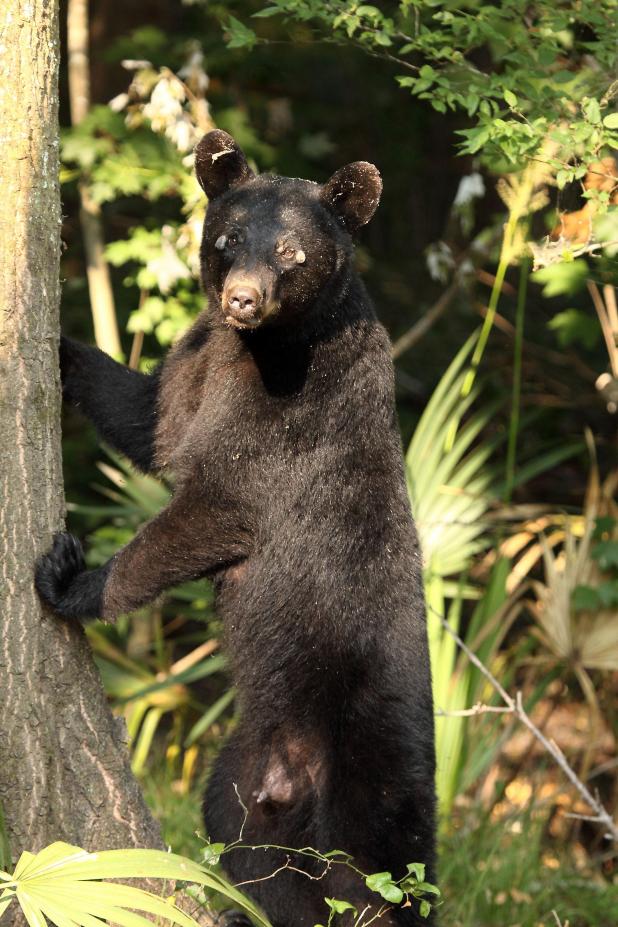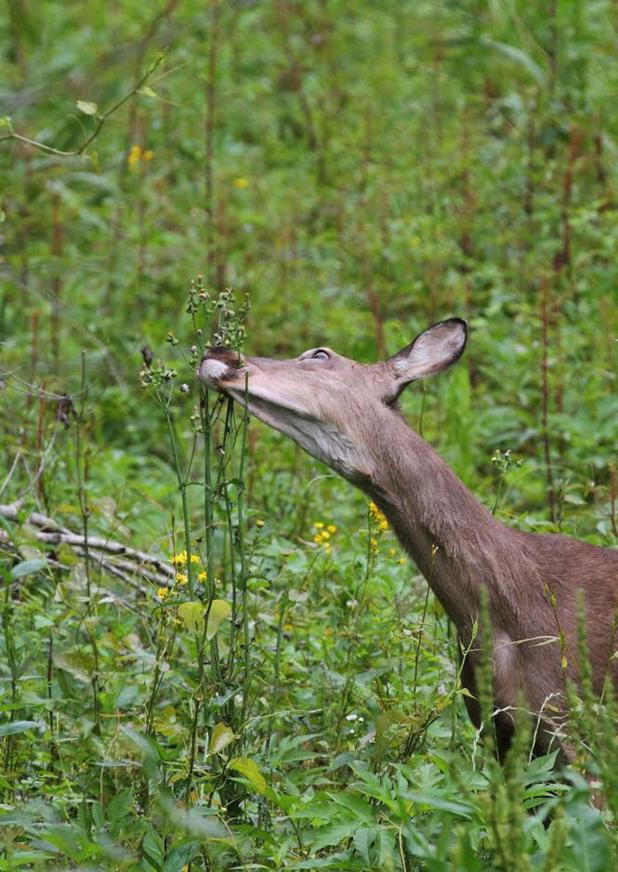
Bayou Teche National Wildlife Refuge was established 2001 as habitat for the endangered Louisiana black bear, which has been delisted.

This Bayou Teche white-tail doe deer feeds on the edge of a refuge hiking trail.
The Daily Review/John Flores
John Flores: Should hunting be expanded at Bayou Teche wildlife refuge?
Established in 2001, Bayou Teche National Wildlife Refuge in St. Mary Parish is made up of 10,999 acres of bottomland hardwood forest, cypress-tupelo swamps, and marshes that was intended to provide habitat for the then endangered Louisiana black bear.
The refuge’s diversity allows it to support other species of fauna such as wading birds, passerines, and raptors like Bald Eagles, Osprey and Swallow-tailed Kites. Its habitat is also important to neo-tropical songbirds that pass through the region during spring migration and is home to a local favorite yellow bird, the Prothonotary Warbler.
In addition to bears and birds, there is a large population of alligators. The refuge is also home to whitetail deer, along with some small game animals like squirrels and rabbits, and non-game creatures like coyote, feral hogs, opossums, raccoons and armadillos.
On April 14, the United States Fish and Wildlife Service issued an Informational Bulletin seeking public comment on proposed hunt program changes for the Southeast Louisiana Refuge System. Bayou Teche NWR is one of the refuges in the system.
The objective of the hunting changes is to expand access to hunting and fishing where it is compatible with refuge purposes.
The mission of the National Wildlife Refuge System, according to Federal Regulation is, “To administer a national network of lands and waters for the conservation, management, and, where appropriate, restoration of fish, wildlife, and plant resources and their habitat within the United States for the benefit of present and future generations of Americans.”
Nationwide there are 567 National Wildlife Refuges, where in large part they have been successful in achieving these mission objectives.
Like it or not, the Louisiana black bear was removed from the Endangered Species List in May 2015. What’s more, ask locals from Patterson to Franklin who live south of the railroad tracks below U.S. 90 about the local bear population and you’re likely to get an ear full.
However, is expanding hunting opportunity always the wise thing to do?
Bayou Teche NWR, since its inception has held a modest deer hunting season annually consisting of mainly archery hunting and basically five days of gun hunting for youth and adults.
For 2021-22 hunting season the bulletin notes that the previously closed Franklin Unit will be open to hunting and subsequently add 3,600 acres of available hunting opportunity for the public.
Acreage-wise, Bayou Teche NWR consists of 7 non-continuous management units with 7,100 acres of bald cypress and tupelo woods that are considered very wet and covered with surface water (swamp) much of the year. Bottomland hardwoods make up another 2,400 acres of forested habitat. The rest is marsh.
For those who know something about whitetail deer hunting, swamp is considered marginal habitat at best. There may be some browse for deer on the few ridges that occur on the refuge, along with the oil field canal spoil banks, but quality vegetation is quite limited beyond that.
I reached out to two Louisiana Department of Wildlife and Fisheries deer biologists, former Deer Study Leader Scott Durham, and current Deer Study Leader Johnathan Bordelon. Neither biologist was aware of any formal deer browse studies or population surveys that have been conducted on Bayou Teche NWR in years past.
As someone who uses the refuge during the spring and early summer months, on the few occasions I have observed deer on Bayou Teche, they were always coming off of private property adjacent to the boundary lines and moving back onto the refuge for safety. Deer know no boundaries and find food where it’s available.
Annual deer harvest numbers are typically single digit for those willing to legally report and drop them into the self-clearing boxes provided on the refuge. How many deer are bagged on private property while returning to the refuge each day is something in all likelihood reported by the hunter as required by the LDWF for the area he or she hunted in the parish.
In short, actual refuge harvest rates are currently hard to monitor and something probably unknown for Bayou Teche NWR and should be considered when expanding hunting opportunities.
Other things that are questionable with expanding hunting opportunity on the refuge are found in the “Comprehensive Conser-vation Plan” section of the bulletin. The plan includes increased opportunity for light and dark geese. Light geese would be Snow Geese and Ross’ Geese and dark geese would include the Greater White-fronted Goose, fondly known as speckle bellies.
There is absolutely no chance — zero — of killing snows or speckle belly geese on Bayou Teche NWR.
In speaking with Bayou Teche NWR Assistant Manager Brian Pember, he said, “We’re trying to align refuges with state Wildlife Management Areas to create more hunting opportunities.”
The Atchafalaya Delta and Sherburne WMAs both have waterfowl hunting where geese are regularly killed. However, the habitats compared to Bayou Teche are totally different.
The Atchafalaya Delta WMA is brackish water marsh with plenty of three corner grass, arrowhead, American lotus and subaquatics. Sherburne WMA, on the other hand, has managed water control structures in agriculture settings.
Other things written in the CCP mentions increased opportunity for the incidental harvest of armadillos and opossum. The bulletin appears to encourage the indiscriminate killing of nongame species of animals that have no food value.
There are safety concerns that should also be taken into consideration. Both deer and squirrel seasons coincide with one another. With limited land to hunt, the spoil banks, ridges and headlands could become a problem.
The CCP also mentions allowing deer hunters to put up a properly marked stand 48 hours prior to the season and taking it down no later than 48 hours after it closes. This in itself encourages hunters to take ownership of public property and sets the stage for confrontation.
Is expanding hunting opportunity a wise thing to do? There are a lot of unanswered questions. An important one that should be asked is, what is the impact of increased hunter activity going to have on black bears? Maybe none, but it should be taken into consideration.
The USF&WS is encouraging hunters and the general public to comment on the proposed changes. For those interested they can go to the USF&WS URL www.fws.gov/refuge/big_branch_marsh/cosa/2021_Hunt_package.html or contact USF&WS Refuge Manager Danny Breaux by email at southeastlouisianarefuge@fws.gov or calling (985) 882-2030.
